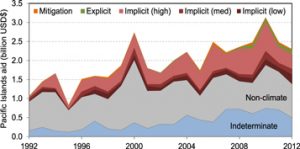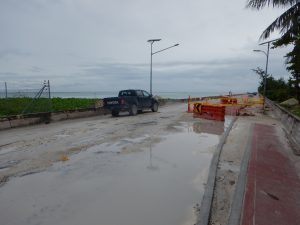As part of the United Nations (UN) climate agreements, the developed world has promised to provide at least US$100 billion per year by the year 2020 to help the developing world respond to climate change. The funding may come in many forms, from grants to private investments. There is one key stipulation: climate aid must be “new and additional” to standard development aid.
What counts, and does not count, as climate aid is the subject of a new study (open access) by my colleagues Milind Kandlikar, Sophie Webber, and I. Accounting may not seem as glamorous as surveying reefs on remote islands, but it is just as important. If we want to help the developing world respond to climate change, we need to make sure any promised aid is actually being provided and meeting the priorities of the recipients.
Current estimates of climate, and especially adaptation, finance are uncertain and contentious because they depend on potentially politically-motivated and value-laden assumptions. For example, as we note in the paper, the UN Framework Convention on Climate Change (UNFCCC) itself concluded that depending on the method of analysis, anywhere from virtually none to almost all of the fast-start financing provided after the 2009 meeting in Copenhagen could be considered additional climate aid.

Pacific Islands aid classified as explicit adaptation, mitigation, implicit adaptation (three levels), not climate-related or indeterminate (Donner et al. 2016)
To address these questions, we tested different ways to assess the fraction of development aid to the Pacific Islands which contributes to climate change adaptation. The results show that the more nebulous and hard to define ‘implicit’ adaptation funding — projects that might contribute to adaptation, but may not specifically state as much — could be as much as an order of magnitude greater than the ‘explicit’ adaptation funding. Accounting for such implicit aid is difficult, yet failing to do so may punish broader development programs which actually enhance people’s capacity to adapt to climate change. Moreover:
Without an adaptation finance tracking system that accounts for such ‘implicit’ or vulnerability-centred projects, there may be political pressure for donors and recipients to create projects that can clearly be labelled as explicitly ‘climate’ aid, regardless of whether it is the most efficient use of resources to build resilience in the recipient country. The results of this study corroborate the charges of ‘rampant mis-categorization’ of aid.
One solution is to discard the binary “climate or not” way of thinking about aid projects. Instead, projects can be assigned a weight according to their climate relevance as is being done in the Climate Public Expenditure and Institutional Review process. Doing so requires a comprehensive and entirely public international database of all aid projects. That way, rather than settle on one accounting of climate finance from the donor organizations, outsiders like academics and non-government organizations (NGOs) could independently check whether the climate aid pledges are being met without hurting development aid. From the conclusion:
Given the decentralized nature of climate finance, a solution might be for the UNFCCC to lead the development of a metadata reporting system and database, but also to establish a rotating cross-institutional analytical team including representatives from NGOs, development banks, and academia. Such a system could help hold parties responsible for the pledge to provide new and additional funding and help build the trust between the governments, institutions, and the public in both donor and recipient countries. In the long run, it could serve a role akin to ‘sunshine laws’ regarding government transparency, ensuring that adaptation funding is targeted where it is most needed and can be most effective, rather than where it best suits a political or accounting goal.

